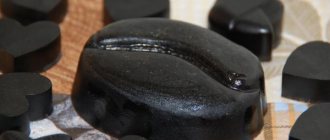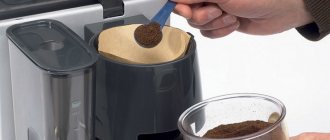You don't have to buy a coffee grinder in a store. You can do it yourself. True, for this you need to have at least minimal engineering skills. You cannot do without the ability to work with a soldering iron and knowledge of the basic laws of working with electricity. Otherwise, you won’t be able to figure out how to make a coffee grinder with your own hands.
About the purpose of the device
Grinding simple coffee beans is the main function of any coffee grinder, regardless of whether we are talking about an electric or mechanical model. Sometimes devices are used to give cereals the form of finely dispersed simple powders. In this case, the reinforced design of all parts is important. Therefore, you need to study the instructions on how to make a coffee grinder at home.
Many people are able to grind spices using a coffee grinder.
The operating principle of the coffee grinder device is described as follows:
- First, the coffee beans are loaded into a special hopper. It is usually installed at the top of the structure.
- Inside the bunker there are millstones that grind the grains into a fraction of the required size.
- A simple bunker is installed below, and the finished powder is collected in this part.
- Additionally, simple buttons are installed to regulate the degree of grinding. There are often switches and portion counters, or a dispenser lever. A DIY coffee grinder is no exception.
Homemade coffee grinder from an engine
Do-it-yourself coffee grinder from a grinder
The “homemade” approach also includes a coffee grinder, which can be made from an old grinder or any other suitable engine.
A homemade coffee grinder made from a grinder is unlikely to be able to compete with modern equipment for crushing coffee. But for the sake of curiosity and your own satisfaction, doing something with your own hands, assembling a coffee grinder from a grinder is quite simple.
Coffee grinder from a grinder or engine
On the Internet you can already find a video on how to make a homemade coffee grinder from a grinder with your own hands. The problem with that design is that it uses sharp knives for grinding coffee, which are ineffective at accomplishing the task.
Or rather they do it, but in the end the coffee needs to be sifted with a sieve after such grinding, which is not very convenient, and in this case there will be a lot of waste.
For this reason, it is better to slightly change the configuration of a homemade coffee grinder and install a cylinder on an engine made from a grinder or any other suitable size and power. Sandpaper is attached to the surface of the cylinder. The size of the coffee grind will depend on the size of the beans.
DIY coffee grinder
1. First, a container is made in which the coffee beans will be ground. The walls of the container should be arranged in the form of a dome so that the ground coffee can easily roll down and be picked up again by the grinding cylinder.
On top, the container for a homemade coffee grinder should be tightly covered with a lid with a small funnel into which new beans could be gradually fed during the grinding process.
2. At the next stage, you need to make millstones for the coffee grinder with your own hands. It is better not to make the cylinder diameter more than 10 centimeters, although the millstones for a coffee grinder can be larger depending on the engine power.
3. The motor from an angle grinder or any other small motor, for example from a VCR, is installed at the bottom of the coffee grinding container. Here you also need to make a hole for the rod, onto which a cylinder with sandpaper for grinding coffee (millstones) will be attached.
Be sure to seal the hole through which the electric motor rod passes with a seal to prevent coffee dust from getting into the motor.
A homemade coffee grinder from a grinder is easy to make with your own hands. You can experiment a lot with its design, add additional elements for ease of use.
The main thing is to always remember about safety measures when constructing anything, including a coffee grinder with your own hands!
Types of coffee grinders
It is worth taking a closer look at each type of coffee grinder to make a decision about what is needed in a particular case.
- Manual models.
Supplied with details in the form of millstones. First you need to operate the handles on the top of the devices, then these parts will spin and grind the coffee.
- Rotary devices of coffee grinders.
With a small volume, it allows you to prepare drinks for several people. The engine and the main mechanisms of the device speed up the work and grind the grains in the shortest possible time.
- Coffee grinder burrs.
The highest quality, most common variety. The inside of the container is equipped with millstones, and grinding occurs as they move closer to each other.
The latest type of coffee grinder is considered optimal for constant use. In this case, a do-it-yourself coffee mill is the easiest to assemble.
Homemade coffee grinder from an engine
Do-it-yourself coffee grinder from a grinder
The “homemade” approach also includes a coffee grinder, which can be made from an old grinder or any other suitable engine.
A homemade coffee grinder made from a grinder is unlikely to be able to compete with modern equipment for crushing coffee. But for the sake of curiosity and your own satisfaction, doing something with your own hands, assembling a coffee grinder from a grinder is quite simple.
Coffee grinder from a grinder or engine
On the Internet you can already find a video on how to make a homemade coffee grinder from a grinder with your own hands. The problem with that design is that it uses sharp knives for grinding coffee, which are ineffective at accomplishing the task.
Or rather they do it, but in the end the coffee needs to be sifted with a sieve after such grinding, which is not very convenient, and in this case there will be a lot of waste.
For this reason, it is better to slightly change the configuration of a homemade coffee grinder and install a cylinder on an engine made from a grinder or any other suitable size and power. Sandpaper is attached to the surface of the cylinder. The size of the coffee grind will depend on the size of the beans.
What materials can be used for manufacturing
It is necessary to decide in advance what exactly will be used in this work.
Of all the types of raw materials for coffee grinder parts, the following are the most widely used:
- Ceramics.
- Metal with the addition of titanium coatings.
- Stainless steel.
- Metal.
- Plastic.
Metal and high-strength ABS plastic are often used to make the body of coffee grinders. The latter type reduces weight, but there is a high probability of increased wear of parts and various parts. Metal devices are more reliable, including a DIY coffee grinder.
Stainless steel, titanium-coated metal, and ceramic are the most popular types of materials used to make coffee grinder burrs and other parts. Ceramic-based parts do not heat up and boast increased resistance to moisture. But getting foreign objects inside can lead to breakdowns of these parts. In terms of reliability and strength of parts, metal still remains the leader. If it has a titanium coating, devices and parts last even longer. Anyone can figure out how to assemble a manual coffee maker.
How to set up grinding operation
In a manual coffee grinder, the grind size is adjusted using a manual adjustment. As a rule, the trim screw is located at the point where the rotating millstone is attached. By screwing it in or loosening it, you can achieve a gap size between the millstones at which the particle size will be optimal. However, you should not overdo it when reducing the gap. If you set it too low, the metal surfaces will rub against each other, creating small shavings that will mix with the coffee and end up in your food.
If a rotary coffee grinder with rotating blades is used, the time for complete grinding is determined by visual inspection. To do this, turn off the coffee grinder, open the lid and assess the degree of readiness. If the powder is not fine enough, the procedure is repeated. Many coffee grinders of this type usually have a lid made of transparent plastic. This allows you to control the grinding process without removing the lid or turning off the engine.
If the coffee grinder operates on the principle of grinding with millstones, then the degree of grinding is regulated using a special adjustment device. This mechanism allows you to increase or decrease the gap between the rotating millstones, and thus change the size of the powder at the exit. In practice, this is expressed in the rotation of the adjustment wheel located on the coffee grinder body. The adjustment algorithm is quite simple. Rotating the wheel in one direction increases the fraction of ground coffee. In the opposite direction - to decrease. In everyday life, everyone can, with a little experimentation, achieve the desired degree of grinding of grains.
Assembly procedure for mechanical coffee grinders
You can assemble the following set with tools for making parts and coffee grinders:
- Wooden bars.
- Simple board.
- Fastening elements.
- Files.
- Strong vice.
- Chisel.
- “Skin.”
- Grinding machine for finishing corners.
- Simple drilling machines.
- Tin sheets with medium thickness.
Electric motors. You can take new ones or those varieties that have already been used before. A manual coffee grinder does not need them.
The assembly stages of this type of device are described as follows:
- The smaller the electric motor you choose, the better. Typically, power up to 300-700 W is enough. It is disassembled, the stator and rotor are separated from each other.
- A hole with a diameter of 8-10 millimeters is drilled inside the rotor, the minimum depth is up to 7 millimeters. The distance is no more than 9-16 millimeters. Some of the holes are located longitudinally, along the rotor axis of the engine of the device. It is necessary that there remain longitudinal lines running from top to bottom of the part.
- Using special grooves of 4-5 millimeters, the holes are connected to each other, the maximum depth is up to 5 millimeters. It's best to use a grinder to create grooves in this part of the grinder. Before starting work, this device is strictly fixed in a vice. At the bottom of the rotor, the grooves are processed especially carefully.
- The chamfer is removed from the top of the rotor. This is the next stage of working with details.
- The rotor is inserted into the motor stator. Small holes are also drilled in its lids into which grains are loaded.
- The loading container is easy to construct from a sheet of tin. The parameters of other parts depend on the engine dimensions. The top fastening is used to complete the work with the parts.
- A special handle is mounted on the shaft of the electric motor. It is this that gives the design of the coffee grinder the rotation effect. You can experiment with the appearance while working. A pin and bolt will help secure the parts.
- The coffee grinder is fixed on a special board.
- Tests are being carried out on finished devices to try out a simple grinding mode. It is better to set the indicator to several revolutions clockwise, and the same number – counterclockwise. A homemade coffee grinder made from a grinder is ready.
Important! Periodic simple cleaning is necessary for any coffee grinder rotor. It is not recommended to pour grains in large portions; because of this, the inside of the machines quickly becomes clogged and stops working.
The best inexpensive models of burr coffee grinders (up to 5,000 rubles)
De'Longhi KG 89
pros
- Quiet
- Stylish design
- Compact
- There are 3 grinding modes - coarse, medium, fine
- Easy to use, easy to clean
- Sealed coffee tray, nothing spills
Minuses
- Coffee sticks to the sides of the container due to static electricity
- There is no grinding dosage regulator in portions, for one cup
- In fine grind mode the powder is not too fine, this can be resolved by manually adjusting the burrs
From 4100 ₽
The disadvantages of this device are completely insignificant. These are found even in expensive models, so they are not critical. The coffee grinder millstones are made of durable steel. The dosage of grains starts at only 2 cups. The grinding mode is regulated by a simple and convenient toggle switch. The model is equipped with a special protection function against accidental activation.
The container is transparent and you can observe the grinding process. Rubber feet are installed on the bottom of the case. Thanks to them, the device will not slide on the table. An excellent choice at a reasonable price, the correctness of which is evidenced by the fact that the model takes first place in the TOP of the best models of electric coffee grinders.
Melitta Molino
pros
- Capacious container (up to 14 cups)
- Fast work
- You can set portions to the number of cups and individually adjust the degree of grinding
- 17 grinding modes
- Very easy to operate and maintain
Minuses
- Coffee, especially finely ground coffee, sticks to the container
- No dosage for 1 cup
From 3400 ₽
The main advantage of the Melitta Molino model is as many as 17 bean grinding modes, which are easily adjusted with a rotary toggle switch. You can quickly grind coffee for a large number of people at once. The grinding disc is removable and can be sharpened. Automatic shutdown will protect the device from overheating. Compact size and original design are pleasant bonuses for optionality and high quality.
Kitfort KT-717
pros
- Can grind coffee in quantities from 2 to 14 cups
- 14 grind levels
- Ergonomic, easy to operate
- Low noise and high speed
- Completely disassembled and easy to clean
Minuses
The container for collecting ground coffee is not installed tightly, the powder scatters to the sides
From 2700 ₽
The budget millstone coffee grinder Kitfort KT-717 is equipped with metal millstones made of the strongest carbon steel. Uniform grinding and a regulator allow you to get coffee for any type of brewing - in a Turk, French press, coffee maker. The model has an automatic shut-off option and a cord storage compartment. The legs of the case are rubberized. The set includes a special brush for cleaning containers. Apart from one small drawback, this model is quite worthy of choice.
Features of assembling manual coffee grinders
Here you cannot do without the help of such a set of tools for making parts:
- Dye. It is better to take acrylic varieties.
- Coffee beans.
- Stainless steel lids.
- A glass of yogurt.
- Wine corks.
- Medium size spatula.
- Furniture handles.
- Knives.
- Silicone glue is at a fairly high temperature.
- Plywood sheets, or simple inexpensive chipboard.
- High density cardboard.
Do-it-yourself assembly from an angle grinder without this tool also has step-by-step instructions.
- A square-shaped piece of chipboard or the same plywood material will serve as a stand for the coffee grinder. Standard sizes are 14 by 14 cm. But you can change this figure depending on personal preferences.
- Carefully cut out 4 rectangles from cardboard, each 12.513 cm.
- Three sides of these forms are glued together with glue.
- The size for the next simple shelf needs to be measured especially carefully. The cardboard device is glued at a height of up to 3-4 cm from the bottom of the structure.
- Then the last of the rectangles is glued on top. It usually has a cutout for a drawer. It is at the same level as the cardboard shelf.
- All that remains is to cut out the other parts of the coffee grinder box. The size of each part is chosen depending on the choice of specific dimensions. At the end of the work, the structure is glued together using all the parts.
- The front side is approximately 9 by 4 centimeters or 3 by 7.5 cm.
- Separately, cut out the parts for the lid and attach the handle to them.
- Place the box on preheated silicone glue.
- Making a coffee grinder involves using a cardboard circle and a board, a furniture handle, a wooden ice cream stick, and a yogurt container.
- Gluing the lids and boxes together, the cardboard with glue is on top. Next comes fixing the stick and furniture handle. The board comes last.
- The surface of the product is painted with acrylic paint. Black shade is most often chosen. We have to wait until everything dries. Then you need to cover the structure with a white layer. If desired, you can choose other shades for a decorative effect.
- You can add other details for decoration.
- Decoupage a coffee grinder using a napkin. The work is completed.
Interesting. The coffee grinder does not need to be turned on at full load right away; it is better to test it first. Then it is easier to find out the strength limits and identify shortcomings if they were made. It’s not that difficult to assemble a coffee grinder from a grinder with your own hands.
Additional Tips
It is not recommended to store ground coffee inside the device for a long time.
It is best to wipe the inside of the container and blades with a cloth every time you use the grinder.
There is no need to immerse the entire coffee grinder in water. You can limit yourself to just wiping the surfaces.
A blender is used to grind other products; this is the optimal device.
If the body is plastic, then the likelihood of rapid failure increases, as with other parts. More often, modern coffee grinders are made of metal. The main thing is to promptly change the millstones or blades after they become dull. The drawing also helps to understand.
Rules for operating and maintaining coffee grinders
In order for the coffee grinder to work as long as possible, you need to follow simple operating and maintenance rules
.
- Do not leave ground coffee
in the device for a long time. - After each grinding, wipe the inner bowl and knives
with a damp cloth. - The device should not be immersed in water when washing
; it is better to limit it to wet wiping. - Machines with plastic housings may overheat and fail during long continuous operation. Such failures are common in the Moulinex and Saturn brands. If you take short breaks in grinding every 20 seconds
, you can increase the life of the coffee grinder. - You should try to avoid chopping other products
. This is what a blender is for. - Dull knives and millstones
should be . The latter must be replaced after grinding 300 kg of grains, and the former - much more often.
By following simple rules for the care and operation of the device, regularly carrying out preventive maintenance and promptly performing minor repairs, you can extend the life of your favorite coffee grinder, which will delight you with many more years of faithful service.
What other nuances should you know about?
An important point is the correct installation of the mesh inside the coffee grinder; the performance of the device largely depends on this. A small protrusion is made at the bottom, just like on the ceiling. The sizes of the circles in each part must coincide with each other. The mesh, due to its elasticity, is independently built into place. Ensuring the correct position of the parts is not so difficult.
The main thing is to assemble such models of coffee grinders so that you can easily replace any of the parts or parts when the need arises.
Don't forget about additional protection. Motors often stop if the shafts become jammed. This occurs when overheated windings melt a fuse.
Be sure to connect the surge protector to the electrical part. Such devices are sold ready-made for washing machines. If necessary, the part can be easily assembled independently, based on a capacitor. Or you can look at washing machine websites, which provide detailed diagrams for internal electrical connections.
All that remains is to copy the element you like and assemble it. This helps protect home appliances from voltage changes.
You can borrow circuits for regulating speed from a food processor. The specified device already has all the necessary degrees of protection. But most combines cannot boast of high efficiency. Indeed, in most cases, people do not measure the energy consumption of devices that operate for no more than 15 minutes.
Washing machines usually have a Hall sensor, which is responsible for speed control.
In the specialized literature you can always find several simpler schemes. The main thing is to take into account the amplitude of the interference that is created by the collector spark. But even the highest quality boards will not completely protect the motor from stopping.
Hall sensors seem complicated, but they will allow you to fully control the work. Often, sanding wheels are generally mounted on rubber plates. This option is not always suitable due to the high probability of surface wedging.
Grounding for coffee grinders is also required. This is necessary to protect against electric shock. Although the device is, in principle, not intended for long-term operation. If it is necessary to process large volumes, it is permissible to use bimetallic plates, which simplify temperature control in the engine.
One of the common options is spare parts for an oil heater.
Video. DIY coffee grinder
We don’t know for what reasons people decide to make a coffee grinder themselves, but we will offer a couple of designs. Moreover, there is no acceptable design for making coffee on YouTube. So, make your own coffee grinder at home.
The designer sees difficulty in regulating the grinding coarseness. A method is needed to obtain fine coffee. The designs with knives proposed on YouTube are not suitable, the coffee flour will be mixed with crumbs, you will need to sift the result, which is unacceptable. A device is required that gradually releases the powder in order to be used as intended. From this point of view, an emery wheel is better suited for a homemade coffee grinder. The grinding speed seems slow, but the quality will please you.
As we see the process:
The colors in the picture show the components. The working chamber is limited to light green. There is a bearing with a seal in the bottom to prevent coffee from spilling into the engine compartment. The finished product is collected along the perimeter (only a segment of the side wall is removed from the sieve). To collect, put a homemade coffee grinder in a saucepan. Let us remind you that the engine compartment has no openings, therefore, we will provide protection for the engine from overheating. It is recommended to include a couple of protective devices in the winding.
Typical thermal fuses are rated at 135 degrees Celsius and are pressed tightly against the wire of the motor coils. Additional point: the motor of the vacuum cleaner is a collector, the homemade coffee grinder is very noisy. If necessary, take an asynchronous motor from the refrigerator; by the way, the device also has a start-up relay (or from a kitchen hood), which ensures safe operation. Brushed motors are renowned for their ease of regulation and ability to operate at frequencies in excess of 50 Hz. In addition, they develop good torque and are little affected by power surges.
Disadvantages of commutator motors:
- High noise level. The brushes rub, the rotation speed is significant.
- Sparking in the collector, therefore, a high level of interference.
When choosing a commutator motor, it is necessary to protect the brushes with varistors (the first end is placed on the brush, the second on the motor housing. There are two varistors - one on each side), it is necessary to build a surge filter into the device.
Standard breakdowns and their fixes
There are several types of malfunctions that device owners may encounter, even if they are made by themselves.
- Broken power cord, bad contacts in the socket.
You need to find the break point using a voltage indicator. Then it will be easier to restore the current, clean the contacts and isolate the junction.
- Damaged switch, stuck engine blocking drive.
In this case, the faulty switch is simply removed from the device. A new part is installed in place of the old part. Thoroughly clean the engine blocking drive, while the cover must remain open. Then you just need to carefully work out the free play.
- The motor runs intermittently. The speed of rotation of the working shaft changes briefly, or stops occur when the start button is turned on.
There is a high probability that this is due to worn brushes. Then simply replacing them is enough.
Sometimes this happens if the collector is dirty. It must be cleaned and wiped with a cloth soaked in cologne and alcohol.
Rewinding coil windings is a more complex type of repair. In most cases, you can easily do without it. It’s easier to replace the entire motor, which saves time and money.
Often owners of coffee grinders are faced with the fact that the bearings have failed. Usually, rubber boots are used to protect parts, but no one is protected from fine dust getting onto the working surface during grinding. Because of this, the armature of the electric motor begins to jam.
But solving the problem with parts is not so difficult. It is enough to clean the bearings and lubricate them with any type of mineral oil. After completion of such work, the parts will last for a long time.
If the knives start to jam, the reason is clearly that the motor winding has burned out. It is almost impossible to correct this situation at home.
Another thing is that if the device’s motor operates under voltage, burning smells appear. Here the reason most likely lies in contamination of the sliding bushings or bearings. You will need to free the shaft and wipe the part near the device with alcohol. Sandpaper or WD-40 is used if you are faced with obvious signs of corrosion. Then the work will become easier.
If a large amount of simple dirt is noticeable on the collector, you can also wipe all parts with alcohol.
Millstone
Millstones for a manual coffee grinder are made in the form of cones, one of them is fixed, the other is movable. By moving this millstone, you can change the fineness of the grind. But more on that later.
Millstones are usually made from:
- Cast iron
- Hardened steel
- Ceramics
- Stone
What influences the material of the millstones?
The taste of the coffee, the uniformity of the grind and the durability of the grinder. Let's take a look at what each material is.
The cast iron in a manual coffee grinder is very good - durable, not afraid of impacts, very wear-resistant and cheap. On the other hand, cast iron millstones gradually grind down and these shavings end up in the coffee. Therefore, the coffee begins to give off a “metallic” feel. In addition, cast iron has a porous structure and absorbs odors well. Therefore, if you often change the type of coffee, the smells of the previous varieties may get into the new one.
Hardened steel is also good for durability. Its resistance to wear is somewhat lower than that of cast iron, so such millstones wear out somewhat faster. This problem is solved by coating the millstones, for example, with titanium. But this measure greatly increases the cost of the coffee grinder. Although the option turns out to be almost ideal - durable, wear-resistant, the dense and smooth structure of titanium does not allow odors to be absorbed and is easy to clean.
Stone millstones are an ideal option, but very expensive. Usually made from an alloy of ceramics and corundum. Why are they so good? Firstly, it is an environmentally friendly material. Secondly, stone millstones are the only ones that can grind coffee “to dust” for cooking in a Turk. Other materials cannot do this. Thirdly, the complete absence of foreign taste. The impact resistance and abrasion resistance of such millstones is excellent. If you don’t throw it away, you can give it to your grandchildren
What to choose?
If funds allow, then feel free to choose a coffee grinder with stone millstones. The only negative is that there are only a few models on the market, so there are no special alternatives.
How to disassemble a coffee grinder if necessary
The design of all devices remains approximately the same. The sequence of actions for the parts will be as follows:
- Be sure to release the knife of the device. To do this, a slot is found at the bottom of the case, a screwdriver is inserted into it, and the part is unscrewed counterclockwise. This also works for homemade devices.
- Usually, immediately under the knife there is a plastic nut or other fastening element of the devices. These parts are unscrewed with a spanner wrench and pliers. They go left or right, continuing to work.
- A plastic or other cup holder with a glass is also dismantled.
- A washer made of metal is removed from the holding axis.
- To get rid of the plate, simultaneously press it together with the blocker. Then this part of the device is turned counterclockwise until it comes out of the grooves.
- The fixing spring of the device is bent and the switch is released.
- The dirt-proof type of washer is removed from the axle.
- The ring at the bottom of the case is moved aside, the screws that secure the wire are unscrewed
- Pull out the engine of the device, of any type.
When the knife is removed, there is a high probability that the slot on the device will be torn off. After this, it will be impossible to completely disassemble the device. Therefore, it is better to pre-treat the part with WD-40 and wait a little. Then it is easier to unscrew all types of fasteners, and parts of the coffee grinder come off faster.
In most cases, the process of disassembling parts and devices should not be a hassle. It is enough to get rid of 2-3 screws, which are located in the lower part of the case. Sometimes you have to work with the latches to remove parts if necessary.
How to disassemble
But you can see how it is disassembled in the video: Bosch Perhaps the easiest way to disassemble of all coffee grinder samples is the Bosch mkm model
Inside the body, remove the button spring from the groove and remove the button from the hole in the coffee grinder body.
The coffee grinder only works with the lid closed. Repair of an electric coffee grinder Composition and types of electric coffee grinders
Carefully, so as not to tear the conductor away from the locking device, lift and move to the side the metal bar that mounts the electric motor.
First, you need to fix the unit in the hands of an assistant or clamp it in clamps so that it is strictly horizontal. Circuit diagram of the EKMZh electric coffee grinder. Inside the metal bowl, using pliers, turn the plastic holder 13 half a turn to the left or right, securing the bowl, and remove the holder from the hole in the bowl.
Call a specialist to your home
Replace faulty parts and reassemble the coffee grinder in reverse order. The electric motor inside the housing is mounted on two rubber shock absorbers 1 and 11 and secured with a metal strip 10 inserted into the corresponding grooves inside the housing. The coffee grinder capacity is 45 g of coffee beans, which corresponds to 10 cups of coffee per grind.
All devices are equipped with motor blocking when the lid is open and overheating protection. Coffee grinders produced in a long-defunct country are not inferior in productivity to their modern counterparts.
It is possible to adjust the degree of grinding of the grains - from fine to coarse. This is where processing takes place. Unfortunately, my photos of the appearance of this coffee grinder were deleted by mistake, so for the appearance I used a photo taken from the Internet. Many models have added an additional pulse mode, which, by briefly stopping the engine, helps when crushing harder products. Pull out the contact from the coffee grinder switch button housing and move it to the right and disconnect the conductor with the contact from the button.
Coffee beans are ground between two millstones: movable and non-movable. There are six grinding levels, which are set with an adjusting ring by changing the gap between the millstones. For example, in millstone models, the coffee grinder consists of three sections. Replace faulty parts and reassemble the coffee grinder in reverse order. Diagnostics of the Elmaz GOST85g coffee grinder
Final tips
The millstone of the device can be replaced with an emery wheel; it does its job perfectly. The degree of grinding is regulated by the mesh, so it becomes mandatory for any device. If this part is installed incorrectly in the device, the holes and protrusions will not match, and the parts will not give the desired result. Work will be stopped.
3 hinges on the bottom and ceiling of the coffee maker are used to protect and increase the reliability of parts and various parts. They help prevent emergencies, from the simplest to the most complex.
Advantages and disadvantages
A manual coffee grinder is an accessory that will allow you to enjoy both the taste of the drink and the process of its preparation. It looks aesthetically pleasing in itself and will decorate the kitchen, even if it is not used for its intended purpose. And when you use the mechanism, a wonderful aroma spreads throughout the house. But you should not grind sugar in it to obtain powder, grind black pepper or nuts. The device absorbs odors and transfers them to products. As a result, the pepper will smell like coffee, and the coffee will smell like walnuts.
A manual coffee grinder grinds the grain, but does not burn it. The grinding is uniform and its fineness can be adjusted. The cold method of obtaining it allows you to preserve the incomparable taste and aroma of coffee and touch the magic of the drink.
The disadvantages of manual coffee grinders include the fact that they do not have the ability to accurately dose coffee. Here you will have to measure the amount of grains by eye. To prepare one serving, you will have to turn the handle for 1-5 minutes. And grinding a supply for several days is really hard work.
conclusions
Making a coffee grinder at home is not that difficult. Moreover, if you have at least minimal technical and everyday skills in working with parts. It is enough to be patient and ensure that all conditions and rules are followed. Manual and mechanical types of devices differ from each other, but there should be no problems during assembly work. The main thing is not to be afraid to experiment and follow the instructions for assembling the parts. Problem areas and details usually quickly catch the eye and are difficult to miss. All that remains is to eliminate defects in various parts, so that later operation and simple work can continue.
Changing the grinding fineness
Changing the grinding fineness allows you to grind coffee of any fineness for different purposes - from a coarse fraction for a French press to a dusty state for a Turkish coffee.
How does grinding fineness change?
There are 2 options - stepped and stepless and depends on the type of housing. The stepped one is used in coffee grinders with a European body and without a body, the stepless one is used in Turkish coffee grinders.
In the step version, the adjustment does not occur smoothly, but with some steps. To change the fineness, you usually need to unscrew the screw on the handle and turn the adjuster.
In the stepless version, just turn the screw that secures the handle, and the grinding fineness will change.










